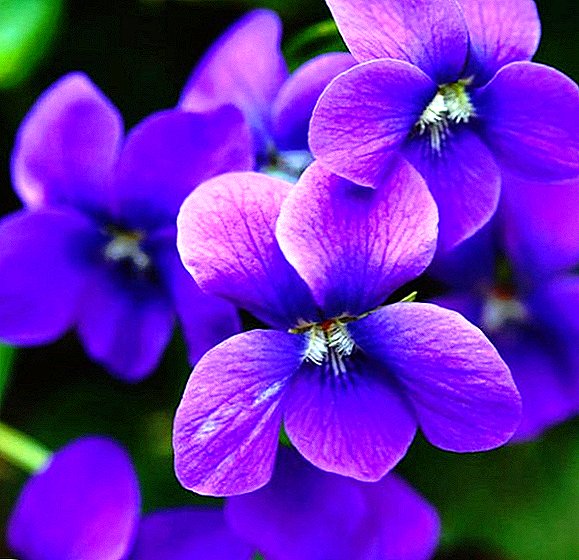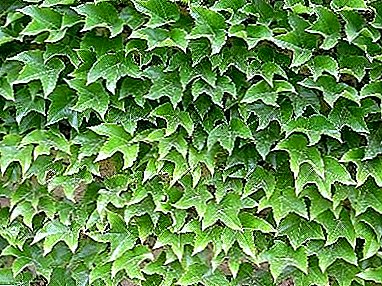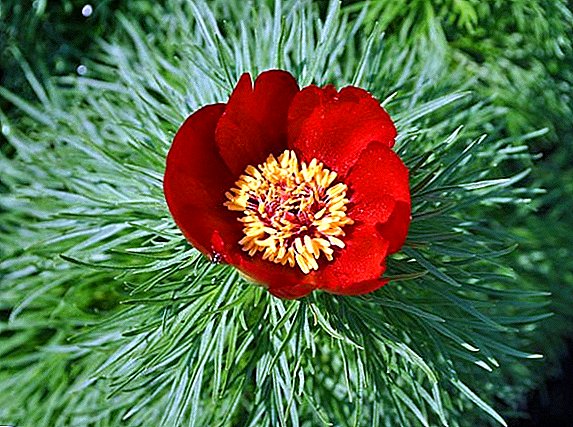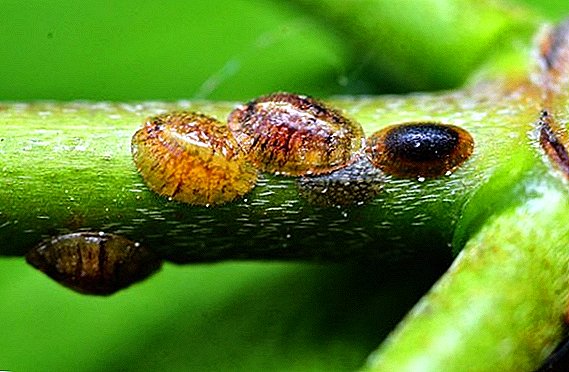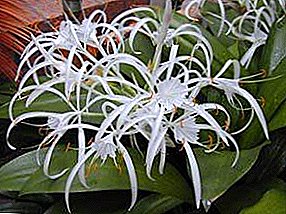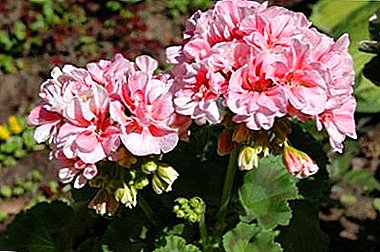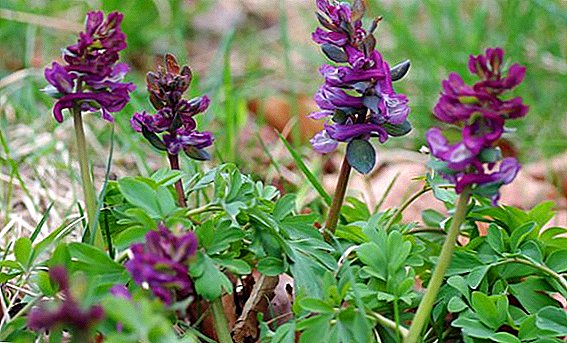 In order to decorate your garden area, unpretentious plants are the best fit. They easily tolerate various weather conditions, have all sorts of decorative qualities, the ability to quickly grow and successfully weave into a pre-conceived composition. Imperata cylindrical (Imperata cylindrica) variety "Red Baron" meets all these requirements.
In order to decorate your garden area, unpretentious plants are the best fit. They easily tolerate various weather conditions, have all sorts of decorative qualities, the ability to quickly grow and successfully weave into a pre-conceived composition. Imperata cylindrical (Imperata cylindrica) variety "Red Baron" meets all these requirements.
Botanical description
This is a perennial plant of the family of cereals. Its height is about 30 cm (sometimes up to half a meter), the stem is erect, the leaves are narrow, rigid, alternately arranged, with pointed tips.
The decorative properties of the grass are provided by the unusual coloring of the leaves: at a young age they are bright green at the base and red at the ends, but by the fall the rich ruby color covers the entire plate, due to which the plant is sometimes called the "Red Lightning" or, given its Asian origin, "Japanese bloody grass. "
The emperor looks very beautiful during the flowering period as well, when she throws out spectacular fluffy 10-3.5 cm long silver-colored panicle spikes that look very contrastingly against the background of red leaves.
In the wild, it happens in spring. But with artificial cultivation of flowering, it is possible to achieve very rarely, in any case, not every year it turns out to admire it. 
Familiarize yourself with the nuances of cultivating such ornamental grasses as Chinese miscanthus, canaries, soddy pike, meadow foxtail, citronella.
Experts, therefore, do not recommend to rely on a blooming emperor when planning landscape compositions. But this is not a particular problem, because the plant looks very impressive thanks to the colorful color of its leaves.
Distribution and habitat
Homeland "Red Lightning" is the south-eastern part of Asia (Korea, China, Japan). But thanks to the ability to grow very quickly, this grass is now widely distributed in almost every corner of the world where the weather is warm enough.
If for European countries "Red Lightning" is a favorite element of landscape design, then for the United States of America this grass is a real disaster and a thunderstorm of local farmers.  This weed (Americans call it kogonovuyu grass) instantly takes wasteland and logging, the wind flows spread over the edges of national highways and displaces other meadow grasses.
This weed (Americans call it kogonovuyu grass) instantly takes wasteland and logging, the wind flows spread over the edges of national highways and displaces other meadow grasses.
The plant is completely unsuitable for use as feed for both wild and farm animals due to too sharp stems. It also makes impossible the nesting places of most birds.
Did you know? Resourceful aborigines of the island of New Guinea have found excellent practical use for sharp stems imperators. It is dried and used to cover the roofs of houses. As is known, dry grass was used as a roofing material in Europe only until the end of the 19th century, but in Oceania, as well as in some Asian, African and Latin American countries, this style has been well used so far.
It must also be said that in tropical countries the "Red Lightning" usually reaches higher sizes than in the temperate zone, reaching up to 80-90 cm. 
Use in landscape design
Landscapers' genuine love for the Red Baron is easy to explain. This bright grass looks great both in group compositions and in single use.
Its ruby-red leaves remarkably enliven the site, bringing unusual bright notes into the overall picture that persist until late autumn, when most of the plants have faded and fallen off. Pay attention to the emperor is if you want to decorate a small area, especially well with its help you can beat the style of the Japanese garden.
"Red Lightning" successfully woven into a well-groomed and neatly trimmed lawn, contrasting with emerald grass. Flower bed can also be effectively diluted with islands of bright red ornamental grass.
Learn more about how to plant a lawn, how to choose lawns, and how to mulch a lawn mower.
 It is no less interesting to combine the cylindrical empire with evergreen needles, especially undersized (for example, juniper). Ordinary deciduous shrubs and green full-blooded also harmonize well with the "Red Baron".
It is no less interesting to combine the cylindrical empire with evergreen needles, especially undersized (for example, juniper). Ordinary deciduous shrubs and green full-blooded also harmonize well with the "Red Baron".Imperata cylindrical looks great in combination with deciduous shrubs such as heather, elderberry, hawthorn, weigela, lilac, forsythia, euonymus, wild rosemary and abelia.
Classic combinations with bloody stems create:
- variegated forms of barberry;
- yellow jasmine;
- various decorative cereals (not red, but bright yellow);
- reed reed;
- pike (or lugovik);
- calamus;
- dvukistochnik;
- fan (or miscanthus).
 A completely separate area is the decoration with the help of the "Red Baron" of its own artificial pond. Even with the help of this original plant, you can very elegantly decorate fresh bouquets or use them as dry-colored compositions to decorate your home for a long and gray winter.
A completely separate area is the decoration with the help of the "Red Baron" of its own artificial pond. Even with the help of this original plant, you can very elegantly decorate fresh bouquets or use them as dry-colored compositions to decorate your home for a long and gray winter.Care and growing plants do it yourself
It's nice that with such wonderful decorative properties the emperor is very easy to maintain and completely unpretentious. In addition, in our latitudes, it does not possess the properties to grow aggressively, capturing new areas. This means that it can be planted without fear for the fate of neighboring crops.
Conditions of detention
Taking into account the origin of the plant, the optimal conditions for it involve a large amount of light and heat. The south or west side of the plot is best suited for this purpose.
Penumbra is permissible, however, in order for the emperor to fully reveal her decorative qualities, at least for a few hours a day she should be illuminated by direct sunlight. 
Important! With an insufficient amount of sun, the leaves of the imperative cylindrical do not acquire that ruby-wine color, for the sake of which, strictly speaking, it is planted on the site.
As for the temperature regime, the Red Baron feels best in the range from +22 to +27 ° C. Usually, “Red Lightning” is grown in open ground, but planting in containers is also practiced (especially this option is suitable for areas with a cold climate, where winters are too severe for heat-loving Japanese grass).
Soil and fertilizer
The composition of the soil "Red Baron" does not impose too high requirements. In the wild, this grass prefers sandy soil and even pebbles, but it will respond to the soil fertile and rich in humus with great gratitude.
A good option is light loam or sandstone, acidity is slightly acidic or neutral (pH level in the range of 4.5-7.8). The most important thing for successful cultivation of imperata cylindrical is to ensure good drainage in order to prevent stagnation of moisture around the root system. 
It will be useful for you to learn more about the different types and properties of soil, fertilizer systems for them, how to independently determine the acidity of the soil on the site, how to deoxidize it, and also find out what it depends on and how to improve soil fertility.
If the grass was planted in fertile soil, it does not require any additional feeding. In subsequent years, quite rarely (a couple of times during the growing season) apply standard organic and complex liquid mineral fertilizers to the soil. At the beginning of the season, it is recommended to focus on potash supplements, and in the fall to use compost.
Watering and moisture
Although the emperor absolutely does not tolerate overwetting of the soil, it is still necessary to water it regularly, especially during the dry season. But the grass does not impose any special requirements on air humidity: it can grow even in the desert! 
Important! Check the degree of soil moisture around the plant (carefully, so as not to damage the roots located in the upper layers of the soil) by digging it with a knife: if the surface layer of the soil is dry to a depth of 2 cm - "Red lightning" it's time to water.
Reproduction and planting
The imperative cylindrical "Red Baron" can be grown from seeds, but in practice the vegetative method of propagation of grass is mainly used - dividing the bush.
Seeds
This method is actively used by the plant in the wild, but only in those climatic conditions that are natural and favorable for it (as already mentioned, in the southern United States, seeds of Kogon grass sprout, barely touching the ground).
In a temperate climate zone, seed germination is low enough, and it is impractical to grow ornamental grass in this way. Nevertheless, the seeds of Impera cylindrical are commercially available. If you want to experiment, you can simply sow them in open ground in late spring.  Good germination is possible only in sunny areas. Before sowing, the soil should be loosened thoroughly, weeds and debris should be removed, slightly moistened, after which seeds are laid out directly on the surface of the ground and sprinkled on top of a thin layer of dry soil.
Good germination is possible only in sunny areas. Before sowing, the soil should be loosened thoroughly, weeds and debris should be removed, slightly moistened, after which seeds are laid out directly on the surface of the ground and sprinkled on top of a thin layer of dry soil.
As soon as shoots appear, start watering. It is important to keep in mind that in dry soil imperates seeds do not germinate, therefore it is necessary to ensure that the soil remains moist.
Did you know? Imperata cylindrical has a diuretic, anti-inflammatory, expectorant, hemostatic, antipyretic and immunostimulating action, due to which it is considered a medicinal plant in eastern medicine. For example, in China, its rhizomes are used - the dried ones are called Baymaogen, roasted on coals - Maogentian. In Russia, this herb is part of some dietary supplements related to products with unproven efficacy.
Also practiced planting seeds in seedlings. In this case, the procedure can begin in late March and early April. If desired, you can order in the online store ready-made seedlings of imperata cylindrical. 
Vegetative
For fast and reliable results, experts recommend using this method of growing "Red Lightning". Vegetative division allows young ornamental plants to be obtained almost immediately, while growing from seed is a long and poorly predictable story.
Transplantation with the simultaneous division of the bush must also be carried out because over time the adult grass begins to grow bald in the center, thus losing all its attractiveness.
The optimal time for the procedure - spring, when the soil is wet enough. The adult shrub should be carefully dug, trying not to damage the earthen room, after which a well-sharpened knife or shovel (the tool should be pre-sanitized) should be carefully cut into several pieces by the root.
You should first prepare a suitable pit for young plants. Its dimensions should be about 2 times greater than the root with the earthy lump remaining on it (usually about 20 cm deep and about the same in diameter).
Video: how to plant ornamental cereals Compost is laid at the bottom of the pit and if the soil is not fertile enough, it is a complex mineral fertilizer. Do not forget about the drainage layer.
Important! The emperor should be planted fairly tightly, because in conditions of a not too hot climate, it grows very slowly.
After laying the bush, the pit is buried, thoroughly tamped, watered abundantly and mulched with a thick layer of compost. The first time after planting is very important to ensure that the earth does not dry up, otherwise the "Japanese bloody grass" has little chance of taking root in a new place.
Wintering and temperature related
Imperata has a sufficiently high frost resistance for a thermophilic plant. In Ukraine, Belarus and central Russia, it can easily endure winter in open ground even without additional shelter. In colder climatic zones, the plant is best grown in containers and in the winter to bring them into the room.
Trim the "Red Lightning" for the winter is not necessary. And yet you need to understand that the middle zone is not a natural habitat for "Japanese bloody grass", and therefore there is no guarantee that it will not die in winter, even if you try to provide good shelter for the cereal (for these purposes it’s best use peat).  In addition, the plant may not tolerate excessive soil moisture during thaws. It is for this reason that many landscape designers initially consider the "Red Lightning" as an annual plant requiring annual renewal.
In addition, the plant may not tolerate excessive soil moisture during thaws. It is for this reason that many landscape designers initially consider the "Red Lightning" as an annual plant requiring annual renewal.
Possible difficulties in growing
Despite the fact that the imperator cylindrical traditionally is considered an unpretentious plant, its cultivation can cause certain difficulties. A lack of sun - and sharp leaves refuse to blush, a lack of moisture - the plant does not take root, an excess of moisture - is killed.
To solve the problem of optimal soil moisture in many ways helps drainage, but there are situations that depend little on the efforts of the gardener, for example, the loss of the bush after a wet winter.
Important! If the plant throws out completely green leaves that do not have red tips, they should be removed, because they have a much higher endurance and a tendency to grow rapidly, while from a decorative point of view they are of no interest.

With proper care, the bush imperatives reach the peak of their attractiveness by the fourth year of life. But to live up to this age, the plant can not always.
Pests, diseases and prevention
"Red Baron" is relatively resistant to diseases and pests. One of the most common problems are fungal infections affecting the plant. This is due to stagnant water in the soil.
The best prevention from this trouble is the right choice of a place to land, ensuring the discharge of groundwater, if they are too close to the surface, good drainage and competent watering.
If the disease does strike the plant, it is necessary to treat it with fungicides as soon as possible (Quadrix, Fundazol and other antifungal agents can be used). Imperata cylindrical "Red Baron" has no analogues in landscape design. 
Did you know? The French add a cylindrical imperator to cosmetology tools, in particular, liquid soap based on the extract of this plant perfectly moisturizes the skin, improves its elasticity, and also makes hair soft and manageable.It is for this reason that this decorative grass with ruby erect sharp leaves is used with pleasure to decorate their plots. But, with all its unpretentiousness, the plant can hardly be called completely "tame". Growing it requires some effort, but the result is worth it!


